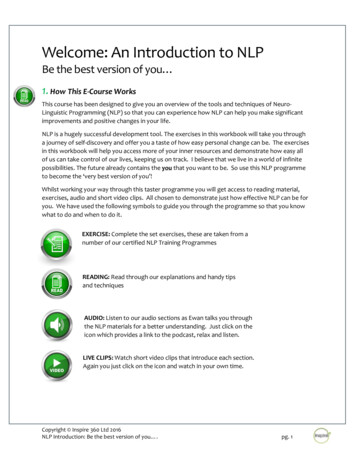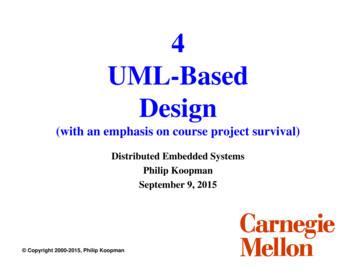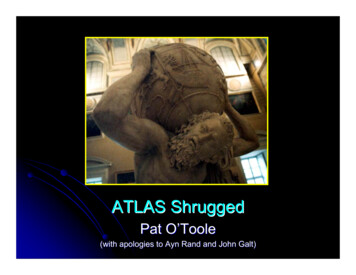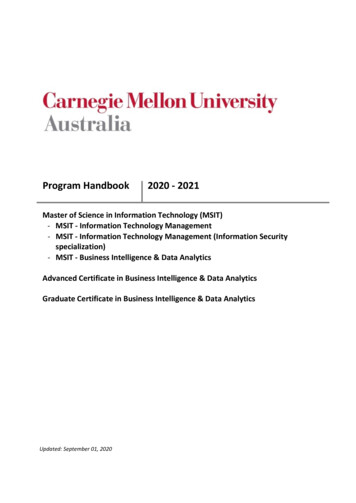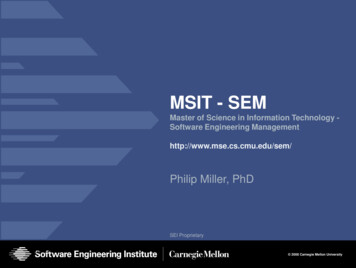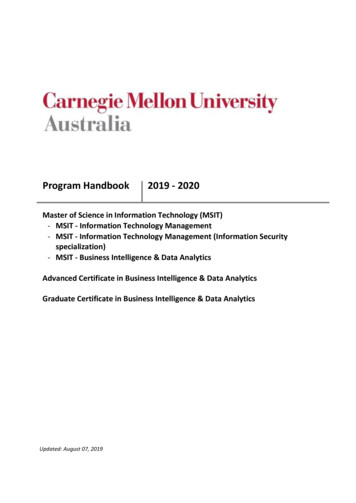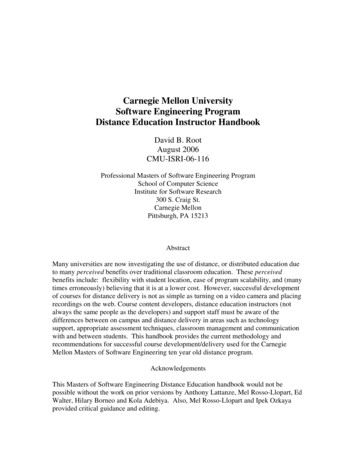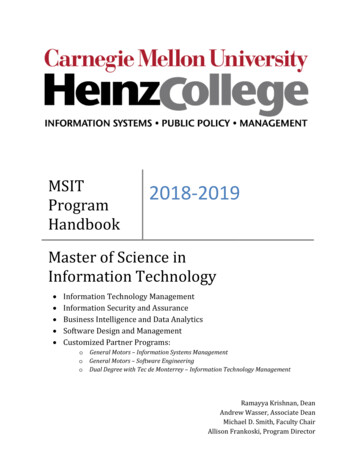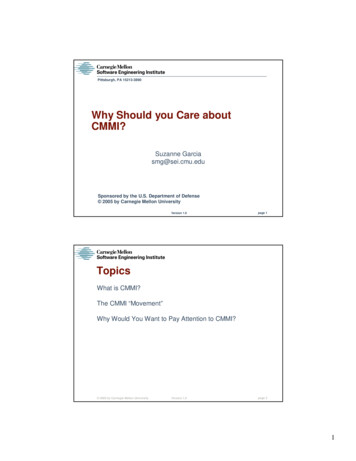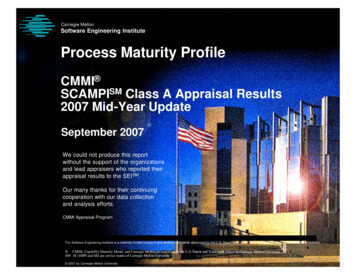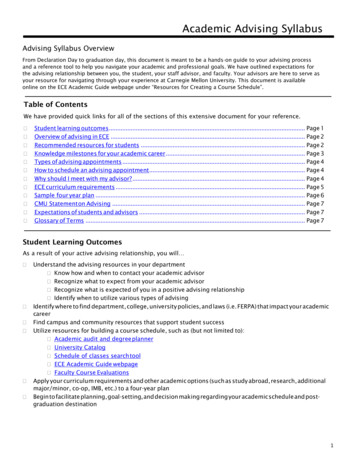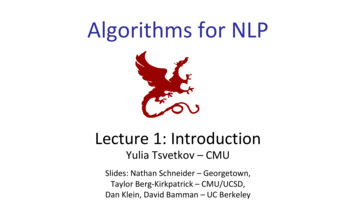
Transcription
Algorithms for NLPLecture 1: IntroductionYulia Tsvetkov – CMUSlides: Nathan Schneider – Georgetown,Taylor Berg-Kirkpatrick – CMU/UCSD,Dan Klein, David Bamman – UC Berkeley
Course Websitehttp://demo.clab.cs.cmu.edu/11711fa18/
Communication with Machines 50s-70s
Communication with Machines 80s
Communication with Machines Today
Language Technologies A conversational agent contains Speech recognition Language analysis Dialog processing Information retrieval Text to speech
Language Technologies
Language Technologies What does “divergent” mean? What year was Abraham Lincoln born?How many states were in the United States that year?How much Chinese silk was exported to England in the end of the 18th century?What do scientists think about the ethics of human cloning?
Natural Language Processing Applications Machine TranslationInformation RetrievalQuestion AnsweringDialogue SystemsInformation ExtractionSummarizationSentiment Analysis. Core technologies Language modellingPart-of-speech taggingSyntactic parsingNamed-entity recognitionCoreference resolutionWord sense disambiguationSemantic Role Labelling.NLP lies at the intersection of computational linguistics and artificial intelligence. NLP is(to various degrees) informed by linguistics, but with practical/engineering rather than purelyscientific aims.
What does an NLP system need to ‘know’? Language consists of many levels of structure Humans fluently integrate all of these in producing/understandinglanguage Ideally, so would a computer!
Phonology Pronunciation modelingExample by Nathan Schneider
Words Language modeling Tokenization Spelling correctionExample by Nathan Schneider
Morphology Morphological analysis Tokenization LemmatizationExample by Nathan Schneider
Parts of speech Part-of-speech taggingExample by Nathan Schneider
Syntax Syntactic parsingExample by Nathan Schneider
Semantics Named entity recognition Word sense disambiguation Semantic role labellingExample by Nathan Schneider
Discourse Reference resolutionExample by Nathan Schneider
Where We Are Now?Li et al. (2016), "Deep Reinforcement Learningfor Dialogue Generation" EMNLP
Why is NLP ExpressivityUnmodeled variablesUnknown representation
Ambiguity Ambiguity at multiple levels: Word senses: bank (finance or river?)Part of speech: chair (noun or verb?)Syntactic structure: I can see a man with a telescopeMultiple: I saw her duck
Scale Ambiguity
Tokenization
Word Sense Disambiguation
Tokenization Disambiguation
Part of Speech Tagging
Tokenization Morphological Analysis Quechua morphology
Syntactic Parsing, Word Alignment
Semantic Analysis Every language sees the world in a different way For example, it could depend on cultural or historical conditions Russian has very few words for colors, Japanese has hundredsMultiword expressions, e.g. it’s raining cats and dogs or wake up and metaphors, e.g. love is ajourney are very different across languages
Dealing with Ambiguity How can we model ambiguity and choose the correct analysis in context? non-probabilistic methods (FSMs for morphology, CKY parsers for syntax) return all possibleanalyses.probabilistic models (HMMs for POS tagging, PCFGs for syntax) and algorithms (Viterbi,probabilistic CKY) return the best possible analysis, i.e., the most probable one according to themodel.But the “best” analysis is only good if our probabilities are accurate. Where dothey come from?
Corpora A corpus is a collection of text Often annotated in some way Sometimes just lots of text Examples Penn Treebank: 1M words of parsed WSJCanadian Hansards: 10M words of aligned French / English sentencesYelp reviewsThe Web: billions of words of who knows what
Corpus-Based Methods Give us statistical informationAll NPsNPs under SNPs under VP
Corpus-Based Methods Let us check our answersTRAININGDEVTEST
Statistical NLP Like most other parts of AI, NLP is dominated by statistical methods Typically more robust than earlier rule-based methodsRelevant statistics/probabilities are learned from dataNormally requires lots of data about any particular phenomenon
Why is NLP ExpressivityUnmodeled variablesUnknown representation
Sparsity Sparse data due to Zipf’s Law To illustrate, let’s look at the frequencies of different words in a large text corpusAssume “word” is a string of letters separated by spaces
Word CountsMost frequent words in the English Europarl corpus (out of 24m word tokens)
Word CountsBut also, out of 93,638 distinct words (word types), 36,231 occur only once.Examples: cornflakes, mathematicians, fuzziness, jumblingpseudo-rapporteur, lobby-ridden, perfunctorily,Lycketoft, UNCITRAL, H-0695policyfor, Commissioneris, 145.95, 27a
Plotting word frequenciesOrder words by frequency. What is the frequency of nth ranked word?
Zipf’s Law Implications Regardless of how large our corpus is, there will be a lot of infrequent (and zero-frequency!) wordsThis means we need to find clever ways to estimate probabilities for things we have rarely ornever seen
Why is NLP ExpressivityUnmodeled variablesUnknown representation
Variation Suppose we train a part of speech tagger or a parser on the Wall Street Journal What will happen if we try to use this tagger/parser for social media?
Why is NLP Hard?
Why is NLP ExpressivityUnmodeled variablesUnknown representation
Expressivity Not only can one form have different meanings (ambiguity) but the samemeaning can be expressed with different forms: She gave the book to Tomvs.She gave Tom the book Some kids popped byvs.A few children visited Is that window still open?vs.Please close the window
Unmodeled variables“Drink this milk” World knowledge I dropped the glass on the floor and it broke I dropped the hammer on the glass and it broke
Unknown Representation Very difficult to capture, since we don’t even know how to represent theknowledge a human has/needs: What is the “meaning” of a word or sentence?How to model context? Other general knowledge?
Models and Algorithms Models State machines (finite state automata/transducers)Rule-based systems (regular grammars, CFG, feature-augmented grammars)Logic (first-order logic)Probabilistic models (WFST, language models, HMM, SVM, CRF, .)Vector-space models (embeddings, seq2seq) State space search (DFS, BFS, A*, dynamic programming---Viterbi, CKY)Supervised learningUnsupervised learning Algorithms Methodological tools training/test sets cross-validation
What is this Class? Three aspects to the course: Linguistic Issues What are the range of language phenomena? What are the knowledge sources that let us disambiguate? What representations are appropriate? How do you know what to model and what not to model? Statistical Modeling Methods Increasingly complex model structures Learning and parameter estimation Efficient inference: dynamic programming, search, sampling Engineering Methods Issues of scale Where the theory breaks down (and what to do about it) We’ll focus on what makes the problems hard, and what works in practice
Outline of Topics Words and Sequences Speech recognition N-gram models Working with a lot of data Structured Classification Trees Syntax and semantics Syntactic MT Question answering Machine Translation Other Applications Reference resolution Summarization
Requirements and Goals Class requirements Uses a variety of skills / knowledge: Probability and statistics, graphical models Basic linguistics background Strong coding skills (Java) Most people are probably missing one of the above You will often have to work on your own to fill the gaps Class goals Learn the issues and techniques of statistical NLPBuild realistic NLP toolsBe able to read current research papers in the fieldSee where the holes in the field still are!
Logistics Prerequisites: Mastery of basic probability Strong skills in Java or equivalent Deep interest in language Work and Grading: Four assignments (individual, jars write-ups) Books: Primary text: Jurafsky and Martin, Speech and LanguageProcessing, 2nd and 3rd Edition (not 1st) Also: Manning and Schuetze, Foundations of Statistical NLP
Other Announcements Course Contacts: Webpage: materials and announcementsPiazza: discussion forumCanvas: project submissionsHomework questions: Recitations, Piazza, TAs’ office hours Enrollment: We’ll try to take everyone who meets therequirements Computing Resources Experiments can take up to hours, even with efficient code Recommendation: start assignments early Questions?
Some Early NLP History1950’s: Foundational work: automata, information theory, etc.First speech systemsMachine translation (MT) hugely funded by military Toy models: MT using basically word-substitutionOptimism!1960’s and 1970’s: NLP Winter Bar-Hillel (FAHQT) and ALPAC reports kills MTWork shifts to deeper models, syntax but toy domains / grammars (SHRDLU, LUNAR)1980’s and 1990’s: The Empirical Revolution Expectations get resetCorpus-based methods become centralDeep analysis often traded for robust and simple approximationsEvaluate everything
A More Recent NLP History 2000 : Richer Statistical Methods 2013 : Deep Learning Models increasingly merge linguistically sophisticated representations with statisticalmethods, confluence and clean-up Begin to get both breadth and depth
What is Nearby NLP? Computational Linguistics Using computational methods to learn more about how languageworks We end up doing this and using it Cognitive Science Figuring out how the human brain works Includes the bits that do language Humans: the only working NLP prototype! Speech Processing Mapping audio signals to textTraditionally separate from NLP, converging?Two components: acoustic models and language modelsLanguage models in the domain of stat NLP
What’s Next? Next class: noisy-channel models and language modeling Introduction to machine translation and speech recognition Start with very simple models of language, work our way up Some basic statistics concepts that will keep showing uphttp://demo.clab.cs.cmu.edu/11711fa18/
NLP lies at the intersection of computational linguistics and artificial intelligence. NLP is (to various degrees) informed by linguistics, but with practical/engineering rather than purely scientific aims. Language consists of many levels of structure Humans fluently integrate all of these in producing/understanding language Ideally, so would a computer! What does an NLP system need to .
